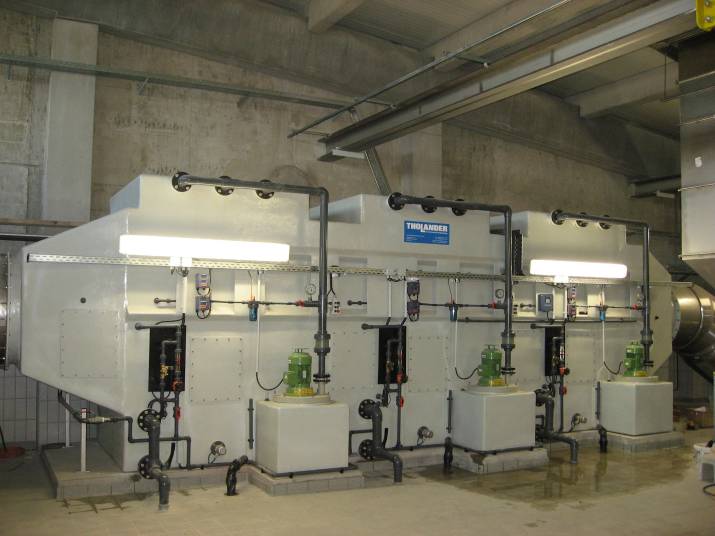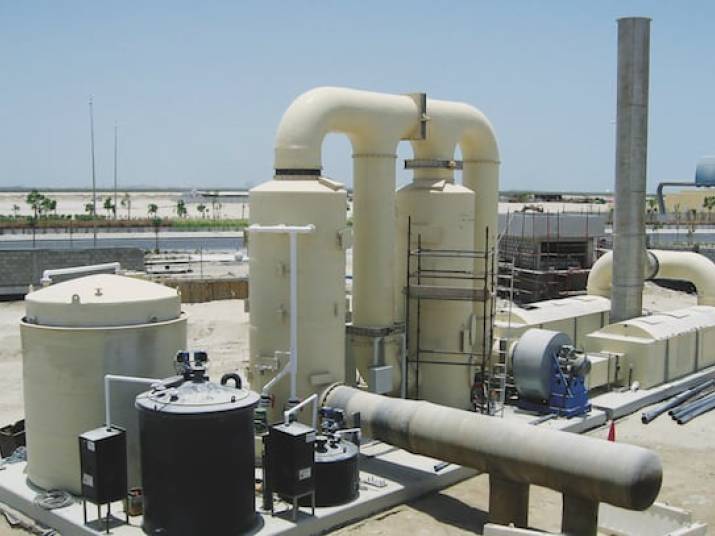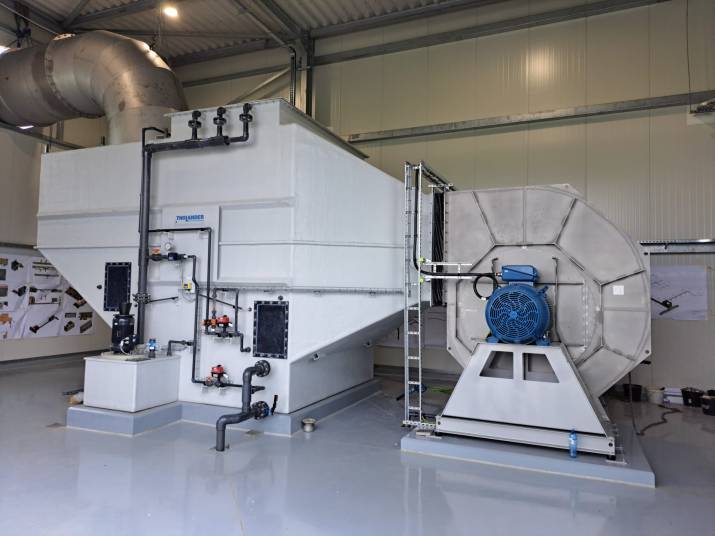Crossflow Scrubber

Crossflow Scrubber
One solution for a wide range of pollutants
Our cross-flow scrubber achieves optimum flexibility. By arranging several scrubbing stages one after the other, dust, acidic or alkaline components of your exhaust air are removed in just one system.
With horizontal scrubbers, the exhaust air flows horizontally through the packing bed and comes into contact with the scrubbing liquid in a “cross-flow”. This transfers the pollutants from the air into the scrubbing water. Depending on the application, a chemical-oxidative or biological mode of operation is possible. Since each scrubbing stage has its own, self-sufficient scrubbing water system, different environments can be set through which the exhaust air must flow. This ensures optimal and targeted removal of the most diverse pollutants in one system.



Benefit from our cross-flow scrubber
- Adaptation to your complex exhaust air
- Multi-stage in one housing
- Simultaneous removal of various pollutants
- Low installation height without loss of performance
- Washing stages are not structurally separated
- Maintenance-friendly control panel
- Efficient supply of fresh water
- Dosing of chemicals as required
- Low pressure loss and low pump power
- Level control in the pump sump
- Dry-run protection
- Monitoring of the nozzle pre-pressure
- Fully automatic, measured value-controlled control of the chemical dosage
- Automatic desalination
- Frost protection for outdoor installation
- Low risk of blockage through selection of the right filling material
- System components made of corrosion- and chemical-resistant materials
- Active references of all sizes
- Worldwide delivery, installation and service
Conception
The operating principle of a cross-flow scrubber is wet separation. In this process, air pollutants and odorous substances flow in a cross-flow, i.e. horizontally through a packed column sprinkled with liquid from above.
The exhaust air comes into contact with the scrubbing liquid. The pollutants and solid particles are removed by physical or chemical absorption, oxidation or condensation. The pollutants accumulate in the aqueous phase and are finally discharged. Depending on the degree of contamination, chemicals such as oxidizing agents can be added to the scrubbing water to increase the degree of separation.
Cross-flow scrubbers are available in one, two, three or more stages. This enables the separation of a wide variety of air pollutants in one system.
Applications
- Sewage sludge drying
- Waste treatment
- Food industry
- Feed production
- Tobacco industry
- Carcass disposal
- Wastewater treatment plants
- Fermentation
- Pumping stations
- Rubber industry
Projects implemented worldwide
with a Crossflow Scrubber

Bern sewage treatment plant / Switzerland
exhaust air is extracted from the waterway and cleaned. The extracted exhaust air is cleaned in a single-stage cross-flow scrubber that works according to the cross-flow principle and two biofilters that operate in parallel.
60,000 Bm³/h of odorous exhaust air is extracted from the sludge treatment plant in Bern and cleaned in three biofilters that operate in parallel.

Composting Plant Rethymnon / Greece
The odorous exhaust air (15,000 m³/h) from the Rethymnon composting plant is extracted and cleaned in a three-stage chemical cross-flow scrubber. The first and second stages are acidic to break down ammonia and water-soluble amines. The third stage is alkaline-oxidizing to break down H2S and mercaptans.

Animal rendering plant Romania
The exhaust air (130,000 m³/h) from the processes and buildings of an animal rendering plant in Romania is to be cleaned. To do this, the exhaust air is first passed through a 3-stage cross-flow scrubber and then into an 1800 m² biofilter.
FAQ about the Crossflow Scrubber
Normally, the filling material do not need to be replaced and have a life expectancy of > 10 years. Should this nevertheless occur (e.g. due to deposits, calcification, overgrowth due to sludge ingress), the filling material can be removed through the maintenance opening located above the support grid. Refilling is carried out via the upper maintenance opening in the area of the nozzle block.
We give no guarantees for odour after a scrubber. If the components can be sufficiently converted into the water phase and react with the added chemicals, the scrubber is very efficient with regard to the separation efficiency of individual substances (e.g. H2S, NH3, mercaptans). However, other odour-relevant compounds may be present in the exhaust gas stream in addition to the lead components mentioned, which cannot be sufficiently separated in the scrubber.
NOx capture is significantly worse. In particular, a distinction must be made here between the individual forms of oxidation. NO2 is captured in the scrubber with 80-90%, whereas NO cannot be retained.
Depending on which substances are to be washed out, a cross-flow scrubber can be designed as a 1-stage, 2-stage or 3-stage scrubber.
A scrubber has a pressure loss of approx. 500 Pascal.
